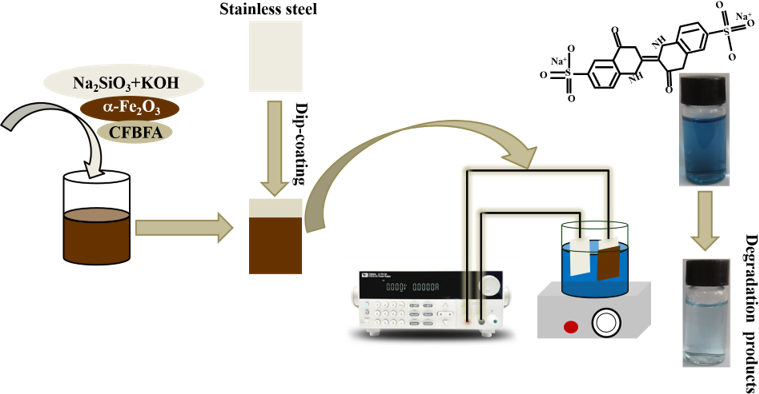 Open Access
Open Access
ARTICLE
An α-Fe2O3/Circulating Fluidized Bed Fly Ash Based Geopolymer Composite Anode for Electrocatalytic Degradation of Indigo Carmine Dye Wastewater
College of Materials Science and Engineering, Xi’an University of Architecture and Technology, Xi’an, 710055, China
* Corresponding Author: Yaojun Zhang. Email:
(This article belongs to the Special Issue: Current Advances in Green Nanomaterials Applications)
Journal of Renewable Materials 2021, 9(12), 2277-2289. https://doi.org/10.32604/jrm.2021.015824
Received 16 January 2021; Accepted 15 March 2021; Issue published 22 June 2021
Abstract
Geopolymers have been developed to various catalysts due to their advantages. However, low conductivity restricts their application in the electrocatalysis field. In this study, an α-Fe2O3/circulating fluidized bed fly ash based geopolymer (CFAG) composite anode was fabricated using a facile dip-coating method by loading α-Fe2O3 in the matrix of CFAG. The effects of α-Fe2O3 content on the composition, surface morphology and electrochemical performance of α-Fe2O3/CFAG composite anode were investigated. The X-ray diffraction (XRD) and scanning electron microscope (SEM) results demonstrated that α-Fe2O3 was successfully inlaid with the surface of amorphous CFAG matrix. The electrochemical measurements indicated that α-Fe2O3/CFAG composite anode had higher oxygen evolution potential, greater electrochemical activity area, and smaller electrochemical impedance than CFAG. The as-prepared composite anode was applied for electrocatalytic degradation of indigo carmine dye wastewater. It was discovered that the highest degradation efficiency over 10α-Fe2O3/CFAG reached up 92.6%, and the degradation of indigo carmine followed pseudo-first-order kinetics. Furthermore, 10α-Fe2O3/ CFAG composite anode presented excellent stability after five cycles. The active hydroxyl radical was generated over the α-Fe2O3/CFAG composite anode, which acted as strong oxidizing agents in the electrocatalytic degradation process.Graphic Abstract

Keywords
Cite This Article
Citations
 Copyright © 2021 The Author(s). Published by Tech Science Press.
Copyright © 2021 The Author(s). Published by Tech Science Press.This work is licensed under a Creative Commons Attribution 4.0 International License , which permits unrestricted use, distribution, and reproduction in any medium, provided the original work is properly cited.


 Submit a Paper
Submit a Paper Propose a Special lssue
Propose a Special lssue View Full Text
View Full Text Download PDF
Download PDF

 Downloads
Downloads
 Citation Tools
Citation Tools